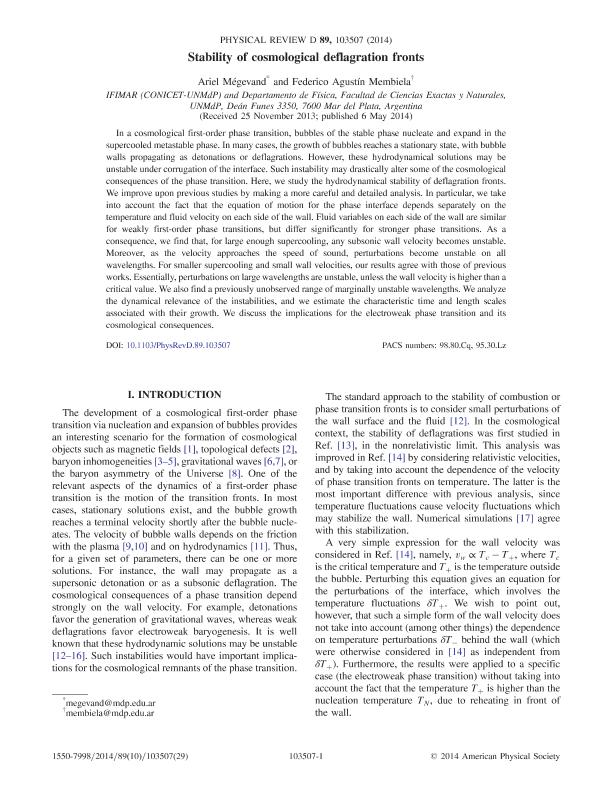Mostrar el registro sencillo del ítem
dc.contributor.author
Membiela, Federico Agustin

dc.contributor.author
Megevand, Ariel Hugo

dc.date.available
2016-11-15T19:28:16Z
dc.date.issued
2014-05
dc.identifier.citation
Membiela, Federico Agustin; Megevand, Ariel Hugo; Stability of cosmological deflagration fronts; American Physical Society; Physical Review D: Particles, Fields, Gravitation And Cosmology; 89; 10; 5-2014; 1-45
dc.identifier.issn
1550-7998
dc.identifier.uri
http://hdl.handle.net/11336/8258
dc.description.abstract
In a cosmological first-order phase transition, bubbles of the stable phase nucleate and expand in the supercooled metastable phase. In many cases, the growth of bubbles reaches a stationary state, with bubble walls propagating as detonations or deflagrations. However, these hydrodynamical solutions may be unstable under corrugation of the interface. Such instability may drastically alter some of the cosmological consequences of the phase transition. Here, we study the hydrodynamical stability of deflagration fronts. We improve upon previous studies by making a more careful and detailed analysis. In particular, we take into account the fact that the equation of motion for the phase interface depends separately on the temperature and fluid velocity on each side of the wall. Fluid variables on each side of the wall are similar for weakly first-order phase transitions, but differ significantly for stronger phase transitions. As a consequence, we find that, for large enough supercooling, any subsonic wall velocity becomes unstable. Moreover, as the velocity approaches the speed of sound, perturbations become unstable on all wavelengths. For smaller supercooling and small wall velocities, our results agree with those of previous works. Essentially, perturbations on large wavelengths are unstable, unless the wall velocity is higher than a critical value. We also find a previously unobserved range of marginally unstable wavelengths. We analyse the dynamical relevance of the instabilities, and we estimate the characteristic time and length scales associated to their growth. We discuss the implications for the electroweak phase transition and its cosmological consequences.
dc.format
application/pdf
dc.language.iso
eng
dc.publisher
American Physical Society

dc.rights
info:eu-repo/semantics/openAccess
dc.rights.uri
https://creativecommons.org/licenses/by-nc-sa/2.5/ar/
dc.subject
Cosmological Phase Transitions
dc.subject
Relativistic Hydrodynamics
dc.subject
Hydrodynamic Instabilities
dc.subject.classification
Física de Partículas y Campos

dc.subject.classification
Ciencias Físicas

dc.subject.classification
CIENCIAS NATURALES Y EXACTAS

dc.title
Stability of cosmological deflagration fronts
dc.type
info:eu-repo/semantics/article
dc.type
info:ar-repo/semantics/artículo
dc.type
info:eu-repo/semantics/publishedVersion
dc.date.updated
2016-11-14T19:33:07Z
dc.journal.volume
89
dc.journal.number
10
dc.journal.pagination
1-45
dc.journal.pais
Estados Unidos

dc.description.fil
Fil: Membiela, Federico Agustin. Consejo Nacional de Investigaciones Científicas y Técnicas. Centro Científico Tecnológico Mar del Plata. Instituto de Investigaciones Físicas de Mar del Plata; Argentina
dc.description.fil
Fil: Megevand, Ariel Hugo. Consejo Nacional de Investigaciones Científicas y Técnicas. Centro Científico Tecnológico Mar del Plata. Instituto de Investigaciones Físicas de Mar del Plata; Argentina
dc.journal.title
Physical Review D: Particles, Fields, Gravitation And Cosmology

dc.relation.alternativeid
info:eu-repo/semantics/altIdentifier/url/http://journals.aps.org/prd/abstract/10.1103/PhysRevD.89.103507
dc.relation.alternativeid
info:eu-repo/semantics/altIdentifier/doi/https://doi.org/10.1103/PhysRevD.89.103507
Archivos asociados
